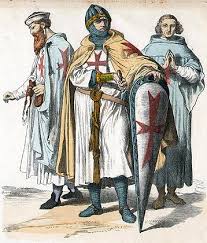Banners played an important role in wars in the medieval ages. They were considered a symbol of moral enforcement, and it distinguished regiments from others on the battlegrounds.
The Knights Templar banner was named the Beauseant. The origin of the word remains unknown, much like many pieces in history.
The Templars were known to be great warriors. They wore white mantles with a red cross in the middle, and they went to war believing in a greater cause. Most importantly, they went silently. It is said that they used to part and attack first and return last. In wars, the Templars received orders from the Grand Master. In attack, they chanted, "Not unto us, O Lord." They were fierce soldiers who were always facing the enemy, even in defeat. However, any Templar who fought against a fellow Christian was punished.
The banner of the Templars was present in all their battles. It is two identical geometric shapes on top of another: the bottom rectangle is white, and the top one is black. However, what truly the banner means has many answers.
The etymology behind their banner is said to be the victory of pureness (white) over darkness (black) and the triumph of good over bad eventually.
Many see The Beauseant as a representation of the sinful secular world that the Templars have abandoned (the black section) under the honorable life of salvation that they have chosen instead (the white section).
Despite all the interpretations and depictions, The Beauseant was something that all group members took pride in. In battles, the banner was held up high on two poles so that everyone could see it, and it didn't need any breeze to stay high.
The banner also had great importance for the Templars, as it reflects what they stand for. In a time of war, the Marshall chose members to protect him and the Beauseant, and even if he died, the banner must stay flying above. The duality remains that as long as the Templars are in battle, the banner must fly, and as long as it's flying, they need to keep fighting.
The Beauseant flying high allowed the Templars to regroup, after separation that is usually caused by their war's tactics and strategies.



